Try this chickpea pizza crust if you are looking for a high fiber and high protein pizza option. I’m taking chickpea flour and making it into a gluten-free pizza crust that your family won’t be able to resist. Feel free to make a socca pizza Margherita or go for a pizza with the works! This chickpea flour pizza crust is perfect with a variety of toppings.
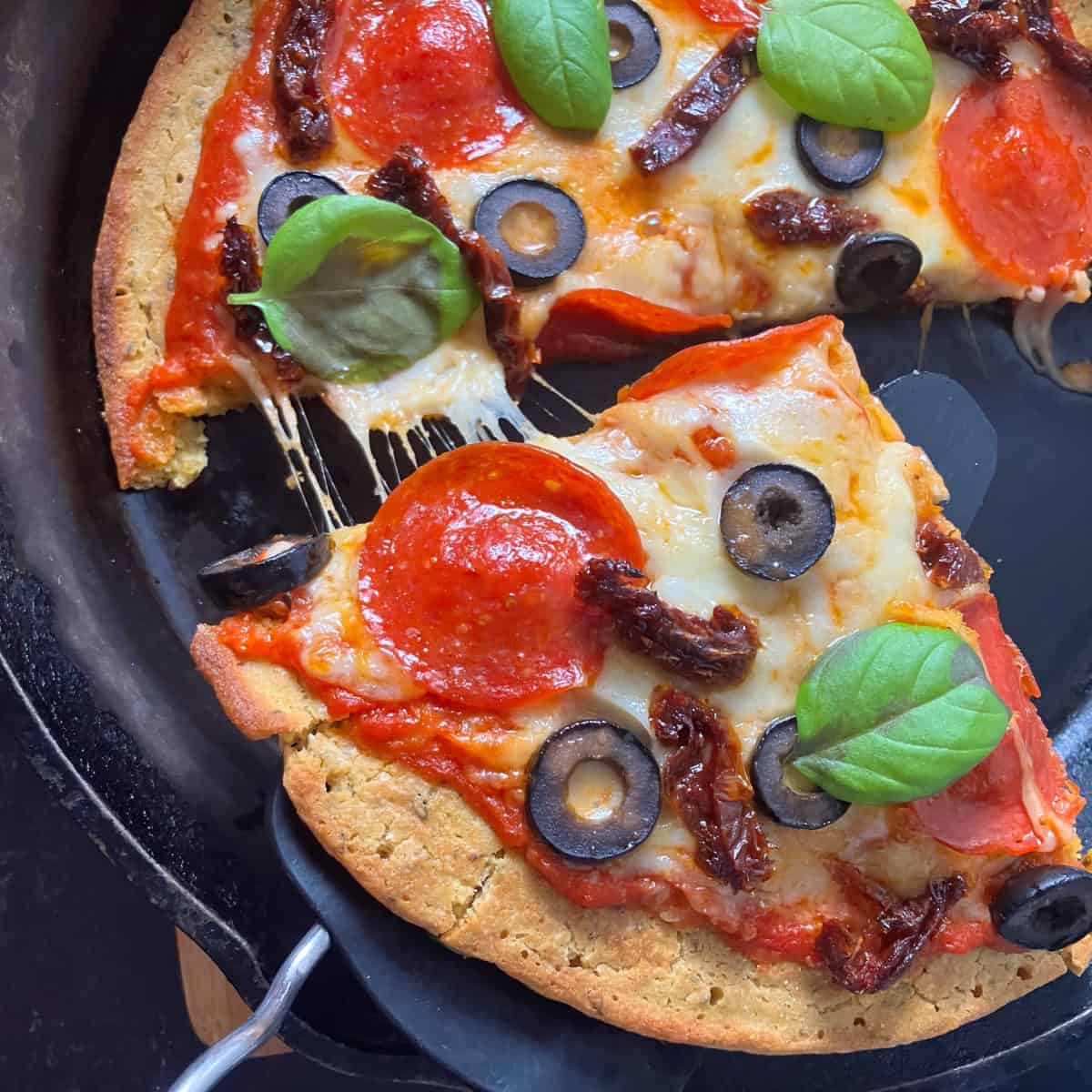
Want to save this post?
Enter your email below and we'll send it straight to your inbox. Plus you'll get great new recipes from us every week!
A couple of months ago, a friend alerted me to the idea of a pizza crust made with chickpeas. Banza pizza has become quite popular in recent years. So, let’s make our own chickpea pizza crust recipe with chickpea pizza dough, shall we?
Table of Contents
- 🍕 Chickpea Pizza Crust Ingredients
- ➕ How to Make Chickpea Pizza Crust
- 🔥 How to Make Chickpea Flour Pizza Dough with Yeast
- 🥫 How to Make Canned Chickpea Pizza Crust
- 🍞 How many carbs are in chickpea pizza crust?
- 👨⚕️ Chickpea Pizza Crust Nutrition
- 👩🏻🍳 More Pizza Recipes
- 📖 Recipe Card
- 💭 Expert Tips from Dietitian Summer Yule
- FAQs
- 💬 Comments
🍕 Chickpea Pizza Crust Ingredients
This chickpea pizza base is essentially a flatbread called socca. Here are the ingredients you need for my chickpea flour pizza crust recipe:
- 1 cup chickpea flour (AKA garbanzo bean flour)
- 1 cup water
- 2½ tablespoons extra virgin olive oil
- Spices and herbs (1 teaspoon each dried basil and dried oregano, salt to taste)
- ⅓ cup pizza sauce
- 3 ounces shredded mozzarella cheese
- Your favorite pizza toppings (pepperoni, olives, onions, mushrooms, bell peppers, chicken, etc.)
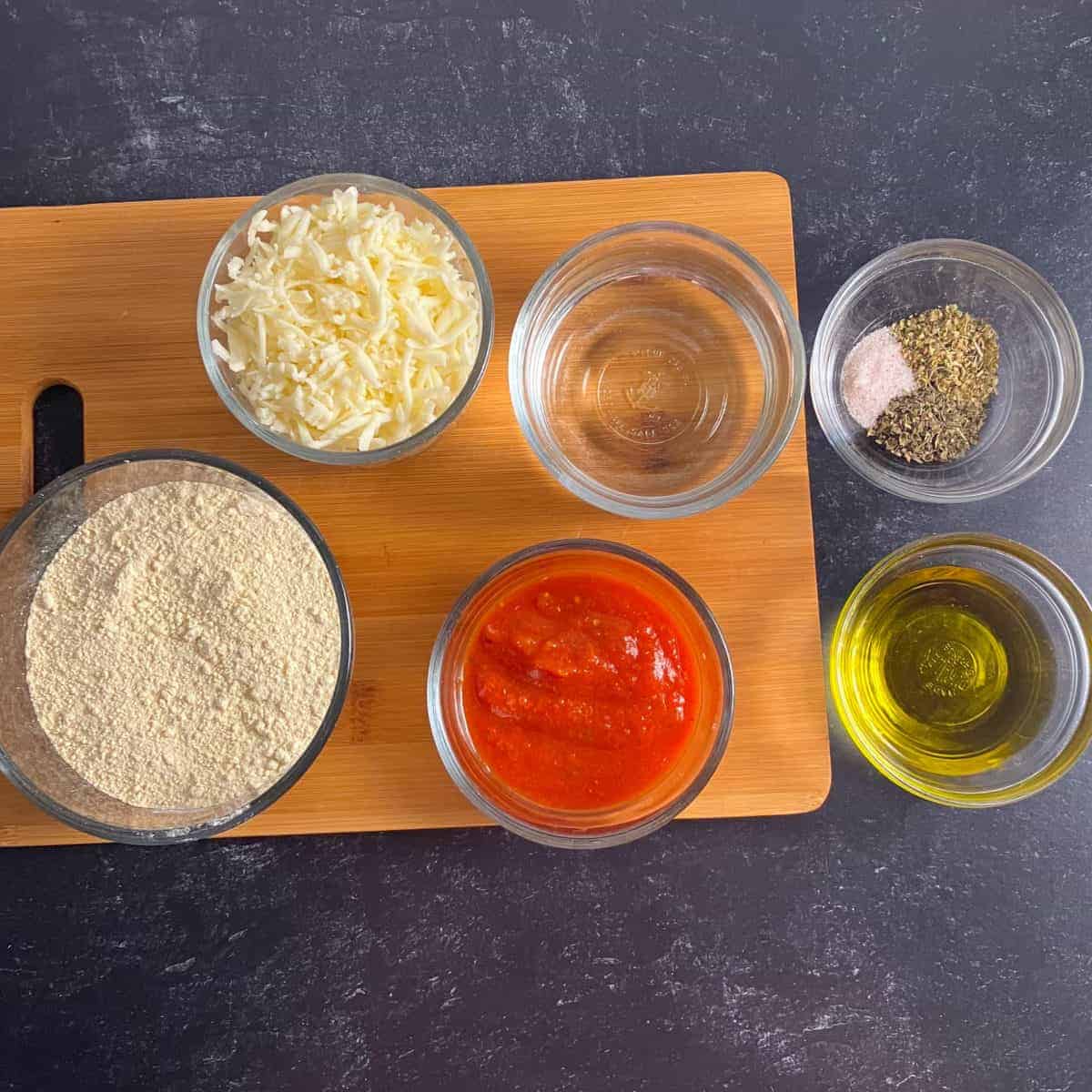
Get a printable recipe card at the end of the post!
Like most gluten-free pizza crusts, this crust made with chickpea flour does have a different texture than those made with white flour. However, it’s still yummy, and you don’t have to eat it with a fork!
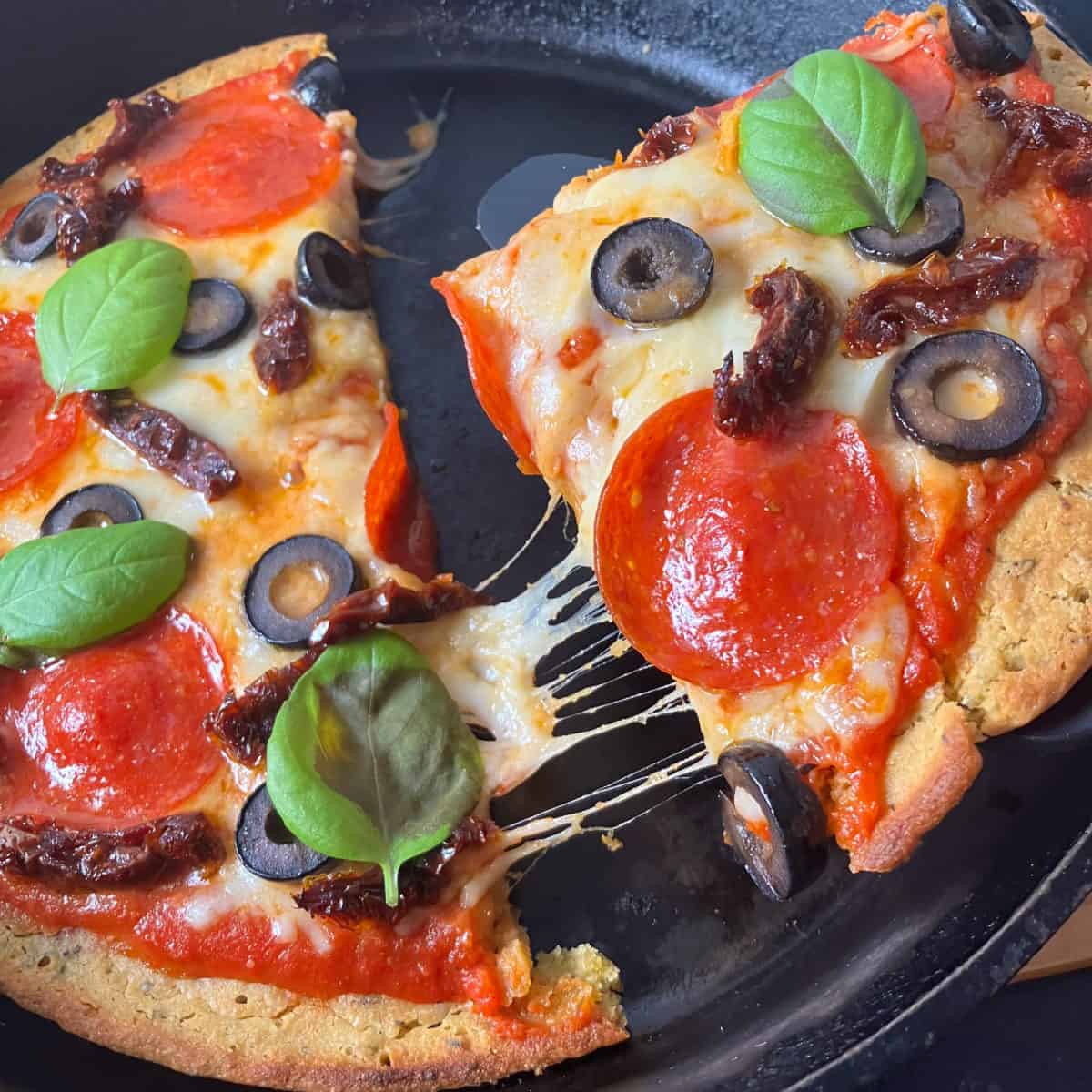
➕ How to Make Chickpea Pizza Crust
Here are the step-by-step directions for how to make a chickpea flour pizza base:
- Whisk the chickpea flour, water, dried basil, dried oregano, salt, and 1½ tablespoons of the olive oil together in a bowl. Keep whisking until the mixture is thoroughly combined without lumps. Let the mixture sit for 30 minutes.
- Preheat the oven to 450F (232C). During the last five minutes of step one, turn your oven to high broil. Put an 11-inch (27.9 cm) cast iron skillet in the oven to heat it up.
- Carefully remove the hot skillet from the oven. Add 1 tablespoon of olive oil to the skillet and swirl to coat the bottom. Pour in the chickpea flour batter and (carefully!) tilt the skillet so the batter completely covers the bottom. If it's too thick, quickly spread the batter around with the back of a spoon.
- Heat the skillet on the stovetop over medium-high heat for 3-5 minutes. It's fine if large bubbles form in the batter.
- Next, place the skillet one-third down from the top of the oven. Broil on high for approximately 5 minutes. Your chickpea crust should be firm and nearly finished cooking.
- Remove the crust from the oven. Let any air bubbles deflate a bit. You can pat them down with the back of a spoon if needed to flatten the crust. Thinly spread the sauce on the crust. It is important to not add too much sauce to your pizza, this will make it soggy. Sprinkle the mozzarella cheese on your pizza, then top with other pizza toppings.
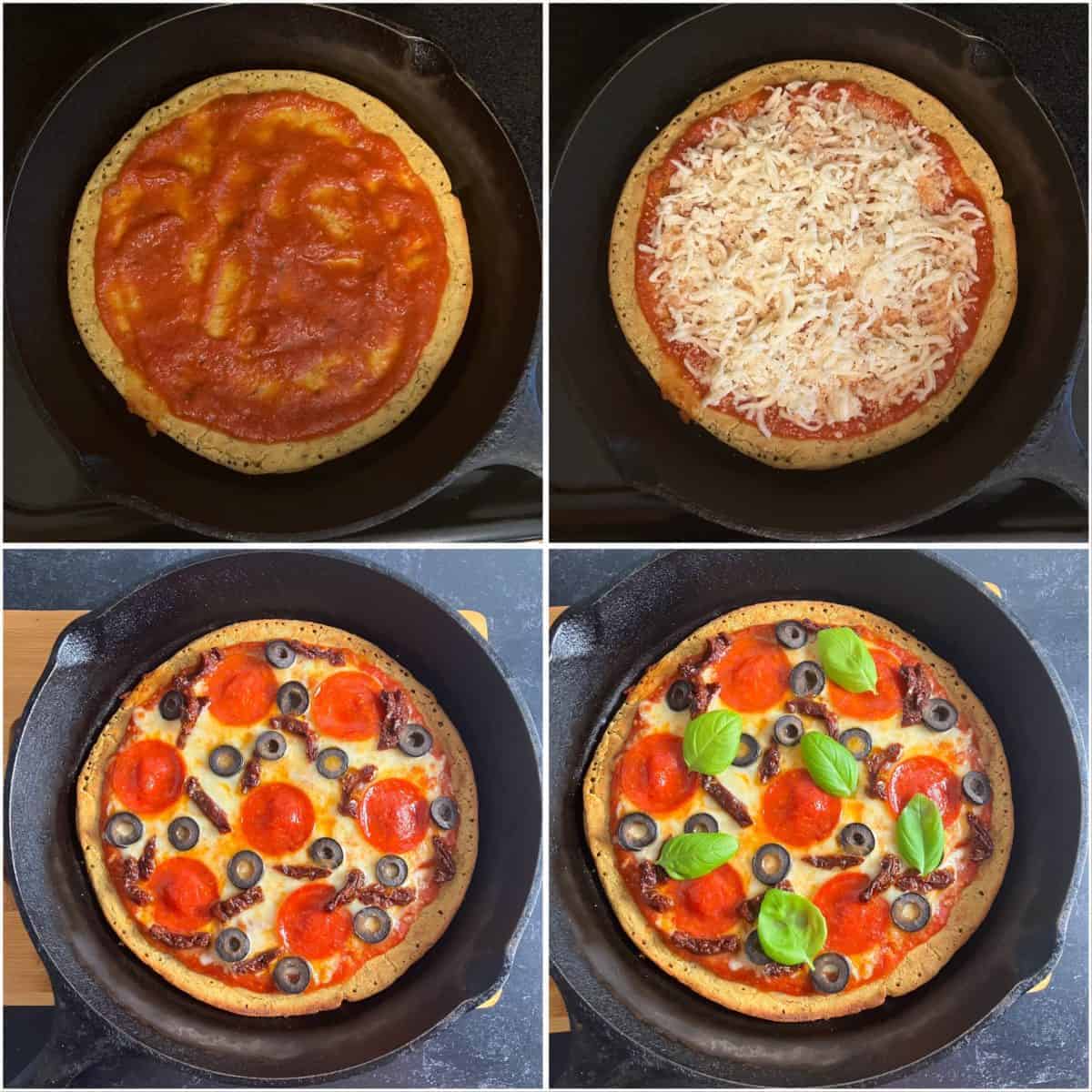
- Return the pizza to the oven and broil on high for an additional 3 minutes. The cheese should melt. Let the pizza cool a bit before cutting into slices.
Chickpea Flour Pizza Crust Tips
I have two main tips to get a grain-free chickpea crust that is sufficiently firm on the bottom without sogginess. Ready?
First, heat the crust in a cast iron skillet on the stovetop for 3-5 minutes BEFORE popping it in the oven to broil. This is the key to make a crust that holds up to pizza toppings. The downside of this method is that the thick batter may form large bubbles on the stovetop.
This is no big deal though. Just pat the bubbles down with the back of a spoon before adding your tomato sauce. The sauce brings me to my second important tip.
Second tip: don’t get overly generous with your toppings that add a lot of moisture. I found ½ cup of tomato sauce was too much.
Add your tomato sauce sparingly! One-third cup looks like it will be too little when you spread it on, but it will be perfect.
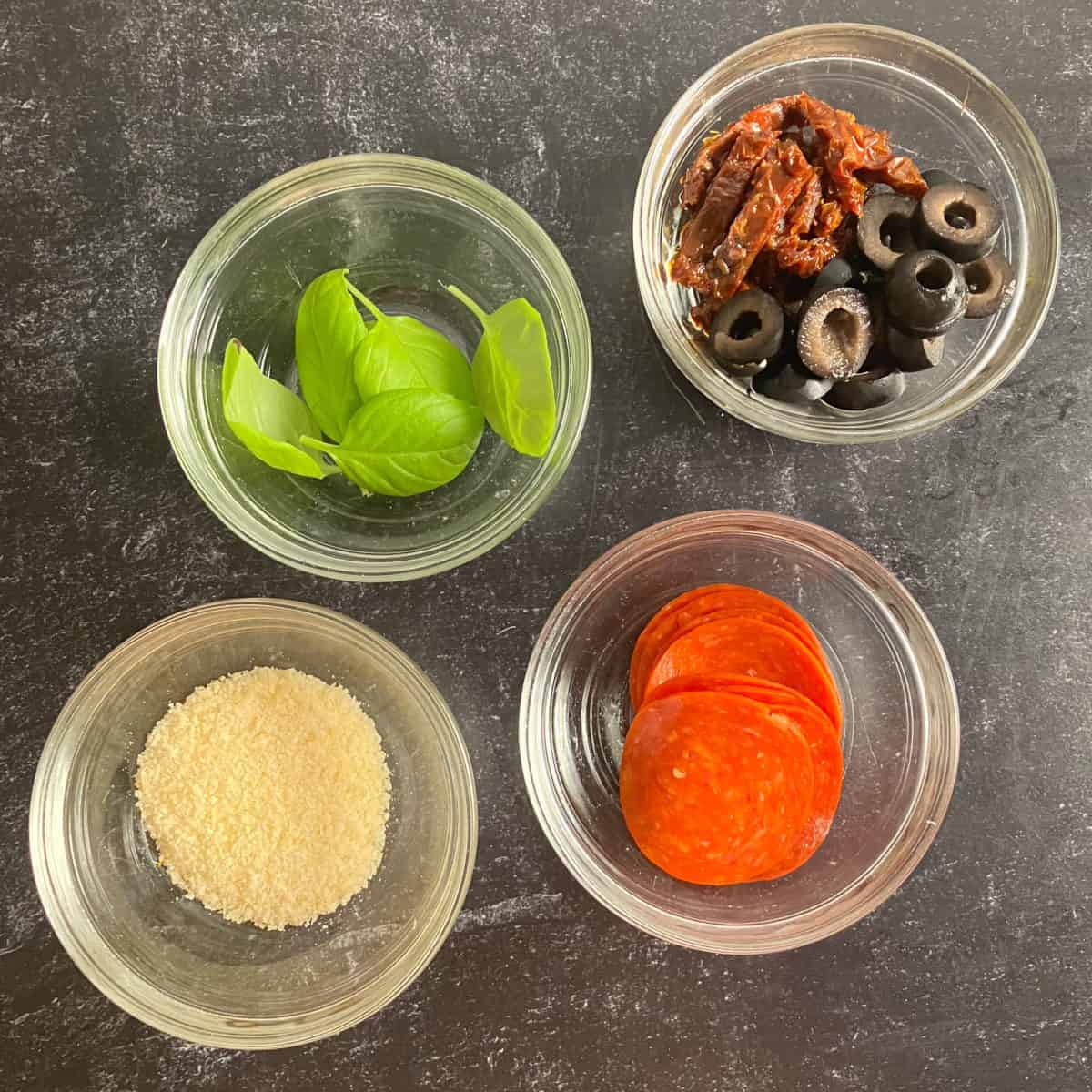
How to Store Chickpea Crust Pizza
Leftover chickpea pizza can be kept in the refrigerator for up to 3-4 days (remove fresh basil). You can reheat chickpea flour pizza using the reheat pizza in air fryer directions to make it crispy again. In short, heat the topped chickpea pizza at 400F (200C) for 3 minutes (air fryer ovens: use top rack).
🔥 How to Make Chickpea Flour Pizza Dough with Yeast
You could make a chickpea flour pizza crust with yeast, but why would you want to? This garbanzo pizza crust recipe has no leavening like yeast or baking powder. It’s basically an unleavened flat bread, and it works great for pizza.
So, make life easier on yourself and skip the chickpea flour yeast pizza dough. Since chickpea flour is a gluten-free flour, you’ll need to use a mix of flours and starches to get the yeast dough to hold together. This is the best chickpea flour pizza crust recipe, because the only specialty flour you need is chickpea flour.
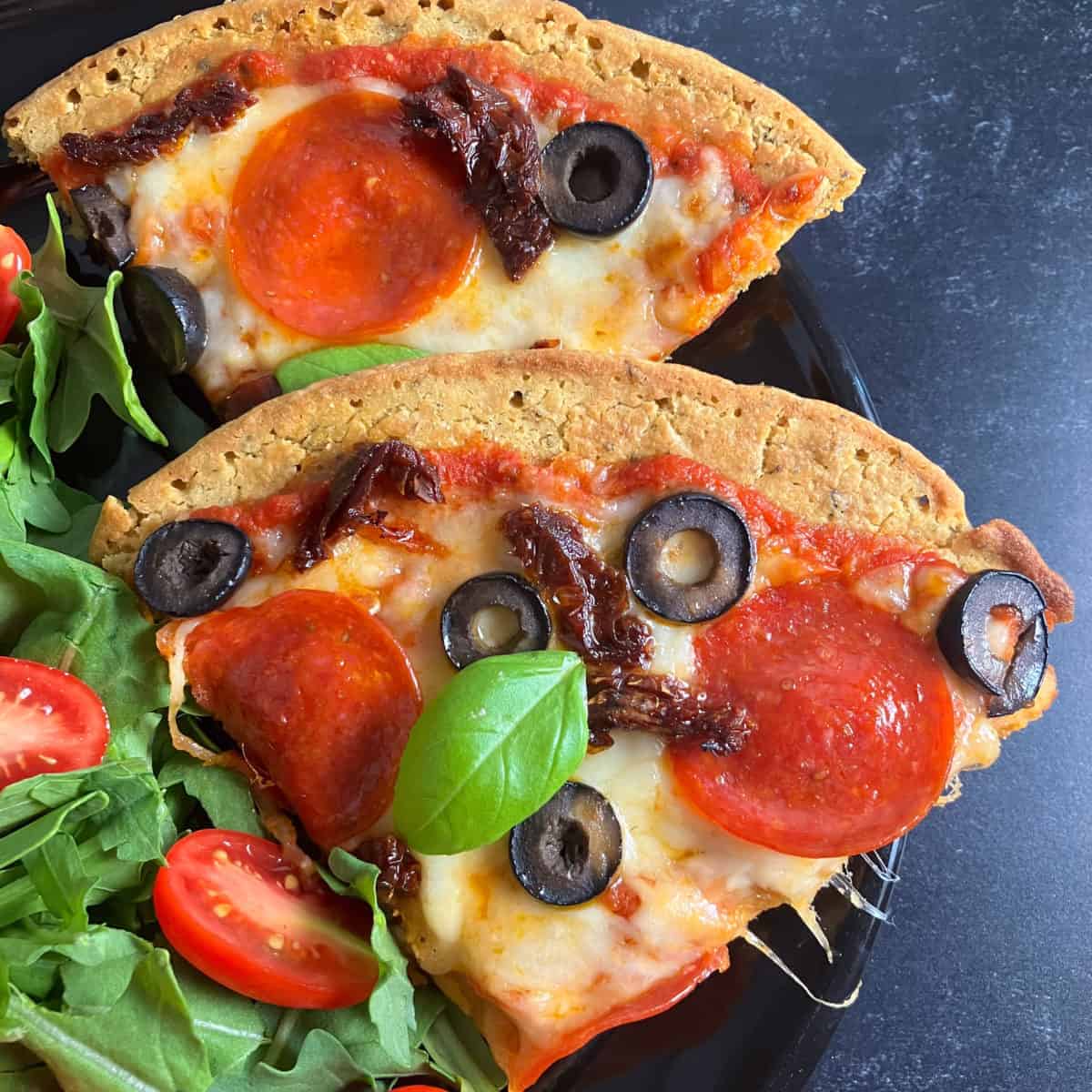
🥫 How to Make Canned Chickpea Pizza Crust
You can also make pizza crust with canned chickpeas that are pureed. You’ll need to add a binder, such as flour. Canned chickpea pizza slices may fall apart easily, so making a chickpea flour crust might be better.
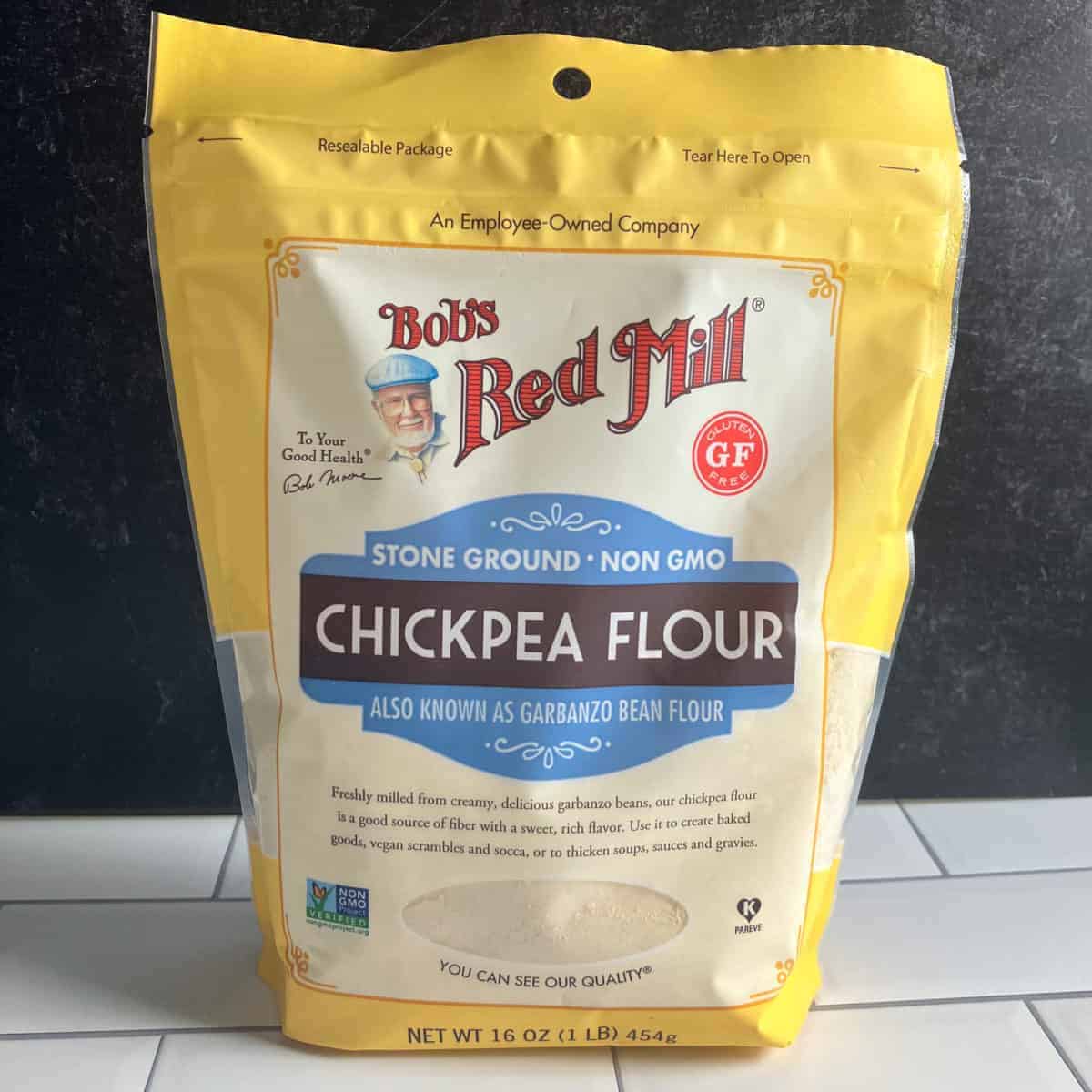
🍞 How many carbs are in chickpea pizza crust?
This chickpea pizza crust has 36.1 grams net carbs per serving, or 37.7 grams net carbs with pizza toppings. Though this is gluten-free chickpea pizza crust with no flour, it is not keto. You may be able to fit this pizza into more relaxed low carb diets (e.g., diabetic carbohydrate exchanges).
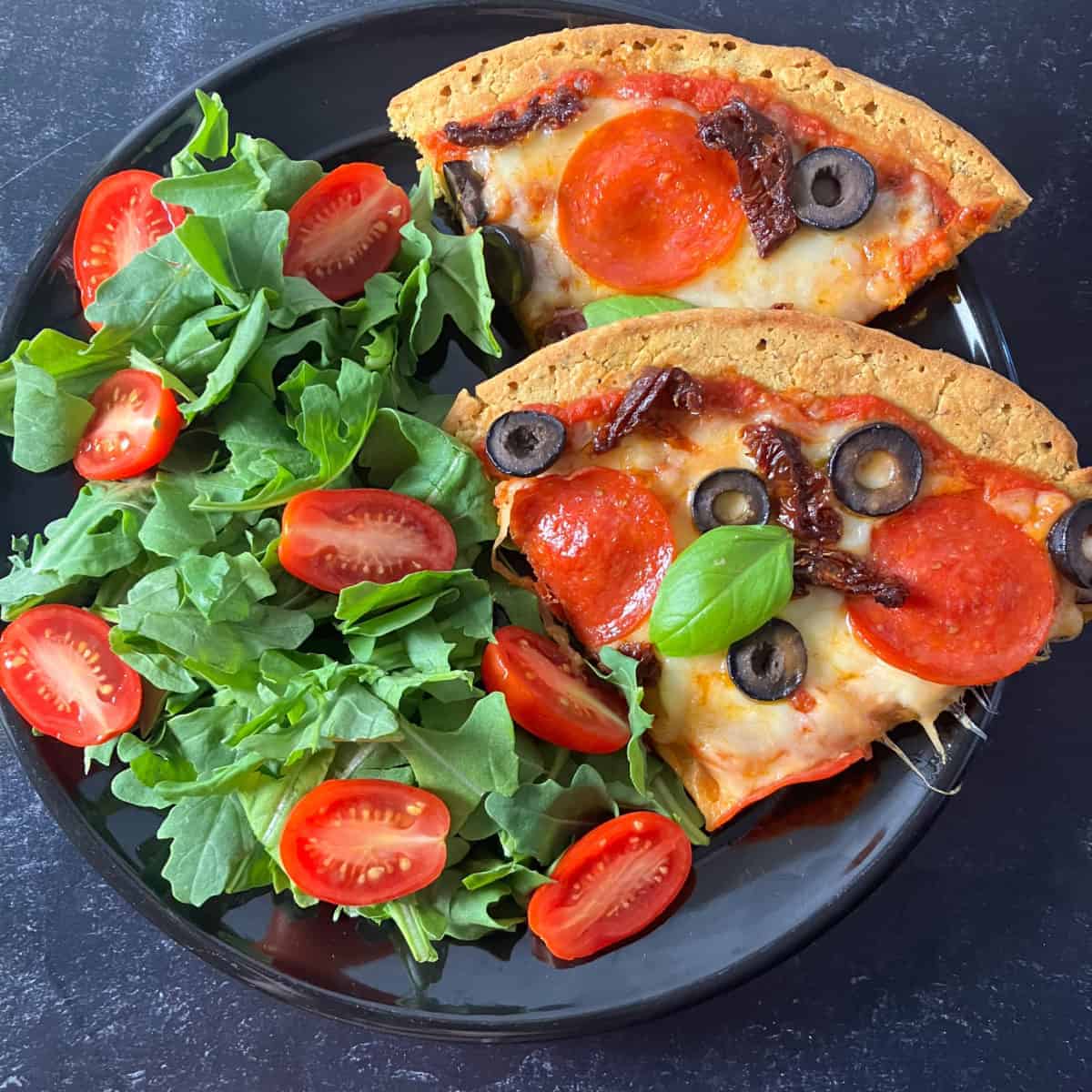
👨⚕️ Chickpea Pizza Crust Nutrition
Here’s the nutrition info for this chickpea crust pizza (tomato sauce and mozzarella cheese toppings only):
- Calories: 533
- Total fat: 30.2g
- Saturated fat: 7.8g
- Cholesterol: 30mg
- Sodium: 1041.7mg
- Total carbohydrate: 47.3g
- Fiber: 11.2g
- Net carbohydrates: 36.1g
- Total sugar: 3.7g
- Protein: 21.3g
- Vitamin A: 7.1%DV
- Vitamin C: 0%DV
- Potassium: 910mg
- Iron: 27.7% DV
- Calcium: 39.7% DV
To make your chickpea flour pizza crust vegan, all you need to do is use vegan cheese alternatives and other dairy-free pizza toppings. Easy!
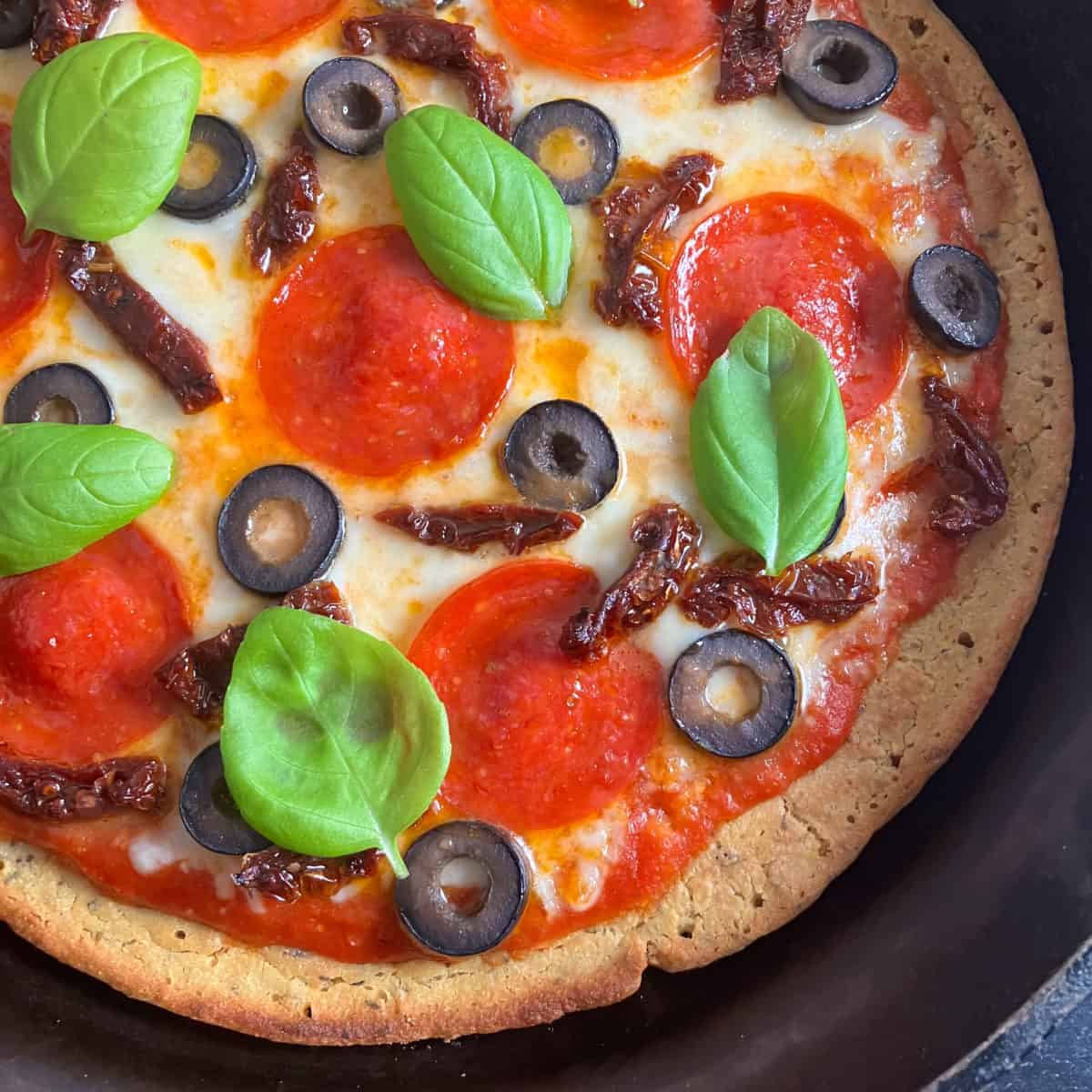
👩🏻🍳 More Pizza Recipes
If a more traditional pizza crust sounds better to you, don’t miss my spelt flour pizza dough recipe. It’s a great choice for those who prefer a thin and crisp crust (though it’s not appropriate for gluten-free diets). Here are some other recipes for pizza:
- Frozen Cauliflower Crust Pizza in Air Fryer
- English Muffin Pizza in Air Fryer
- Totino's Pizza Rolls (Air Fryer)
📖 Recipe Card
Watch How to Make It!
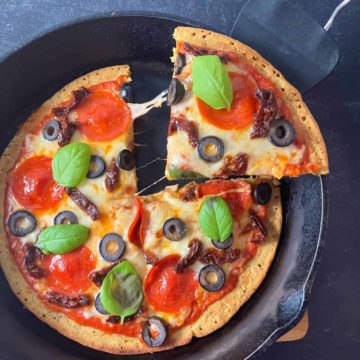
Chickpea Pizza Crust Recipe (Chickpea Flour Pizza Dough Base)
Ingredients
For chickpea pizza crust:
- 120 grams chickpea flour (about 1 cup; weigh it for best results)
- 1 cup water
- 2½ tablespoons olive oil, divided
- 1 teaspoon dried basil
- 1 teaspoon dried oregano
- ½ teaspoon salt
To top chickpea pizza:
- ⅓ cup pizza or tomato sauce (choose one with no added sugar)
- 3 ounces shredded mozzarella 85 grams
- other pizza toppings of choice optional (I used 1 tablespoon sun-dried tomatoes, 1 tablespoon Parmesan cheese, 7 slices pepperoni, 2 tablespoons sliced olives, and fresh basil)
Instructions
- Whisk the chickpea flour, water, dried basil, dried oregano, salt, and 1½ tablespoons of the olive oil together in a bowl. Keep whisking until the mixture is thoroughly combined without lumps. Let the mixture sit for 30 minutes.
- Preheat the oven to 450°F (232°C). During the last five minutes of step one, turn your oven to high broil. Put an 11-inch (27.9 cm) cast iron skillet in the oven to heat it up.
- Carefully remove the hot skillet from the oven. Add 1 tablespoon of olive oil to the skillet and swirl to coat the bottom. Pour in the chickpea flour batter and (carefully!) tilt the skillet so the batter completely covers the bottom. If it's too thick, quickly spread the batter around with the back of a spoon.
- Heat the skillet on the stovetop over medium-high heat for 3-5 minutes. It's fine if large bubbles form in the batter.
- Next, place the skillet one-third down from the top of the oven. Broil on high for approximately 5 minutes. Your chickpea crust should be firm and nearly finished cooking.
- Remove the crust from the oven. Let any air bubbles deflate a bit. You can pat them down with the back of a spoon if needed to flatten the crust. Thinly spread the sauce on the crust. It is important to not add too much sauce to your pizza, this will make it soggy.
- Sprinkle the mozzarella on your pizza, then top with other toppings (except fresh basil, if using). Return the pizza to the oven and broil on high for an additional 3 minutes. The cheese should melt.
- Let the pizza cool a bit before garnishing with the optional basil leaves and cutting into slices. I had no problem cutting the pizza into ¼s. If your slices are falling apart, cut the pizza into 8 slices instead. Enjoy!
Equipment
Notes
💭 Expert Tips from Dietitian Summer Yule
This is a level 3 recipe (weight maintenance and active lifestyles). Is chickpea pizza crust healthy? In short, the healthiest dough for pizza depends on what you’re looking for. The chickpea flour here does offer more filling protein and healthy fiber than a classic white flour crust. However, it may be easier to create the calorie deficit needed for weight loss by limiting products made with flour. I don’t recommend trying to make chickpea flour pizza crust oil-free to cut calories. The oil ensures your pizza slices release from the pan easily. The best chickpea pizza side dishes are the same sort of sides that go with regular pizza. Here are some ideas for what goes with chickpea flatbread pizza:- Vegan Spinach Salad
- Air Fryer Eggplant Fries (Keto)
- Costco Cauliflower Rice
- Trader Joe’s Cauliflower Gnocchi
- Air Fryer Garlic Bread
nutrition info disclaimer
All recipes on this website may or may not be appropriate for you, depending on your medical needs and personal preferences. Consult with a registered dietitian or your physician if you need help determining the dietary pattern that may be best for you.
The nutrition information is an estimate provided as a courtesy. It will differ depending on the specific brands and ingredients that you use. Calorie information on food labels may be inaccurate, so please don't sweat the numbers too much.
"To taste" means to your preferences, which may have to be visual to follow food safety rules. Please don't eat undercooked food x
Nutrition
FAQs
Where to buy chickpea flour pizza base?
You can find Banza chickpea pizza crust at many popular grocery stores in the U.S. This includes Walmart, Target, Stop & Shop, Winn Dixie, and Publix. You can also purchase it online at Amazon.
What are the Banza chickpea pizza crust ingredients?
Here are the ingredients for Banza plain crust pizza: Chickpeas, Water, Tapioca, Cocoa Butter, Olive Oil, Less than 2% of: Yeast, Oregano, Garlic Powder, Salt, Date Powder, Sunflower Lecithin, Xanthan Gum, and Baking Powder.
Does chickpea flour need to be soaked?
Don’t soak the chickpea flour in this recipe. The added moisture will cause your pizza crust to fall apart. You may soak chickpea flour if the recipe calls for it.
Can you eat chickpea flour raw?
No, don’t eat chickpea flour or chickpeas raw. They are very bitter and contain substances that may cause digestive disturbance. Canned chickpeas are precooked and ready to eat.
What are some other names for chickpea flour pizza?
Gram flour pizza base, besan pizza, socca pizza, and garbanzo bean pizza crust are other names for chickpea pizza.
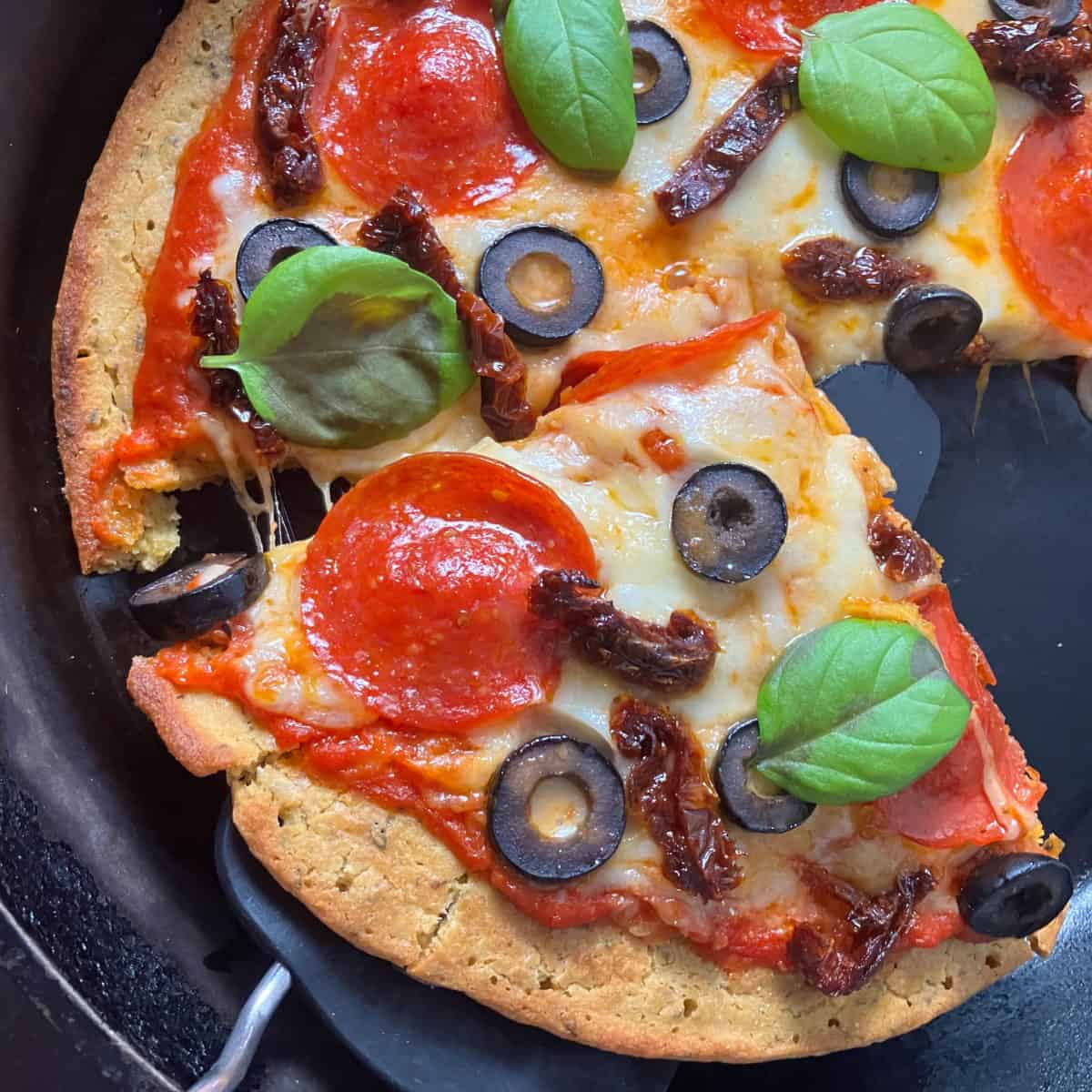
Join our community! Subscribe for all of the latest and greatest recipes, and follow me on Facebook, Pinterest, Instagram, and YouTube!

Hello! I'm Summer, a registered dietitian and home chef who loves to cook, eat, and create high quality content for you! Every recipe on this site has been tested by me to help ensure your success in the kitchen. All eaters are welcome here 🙂


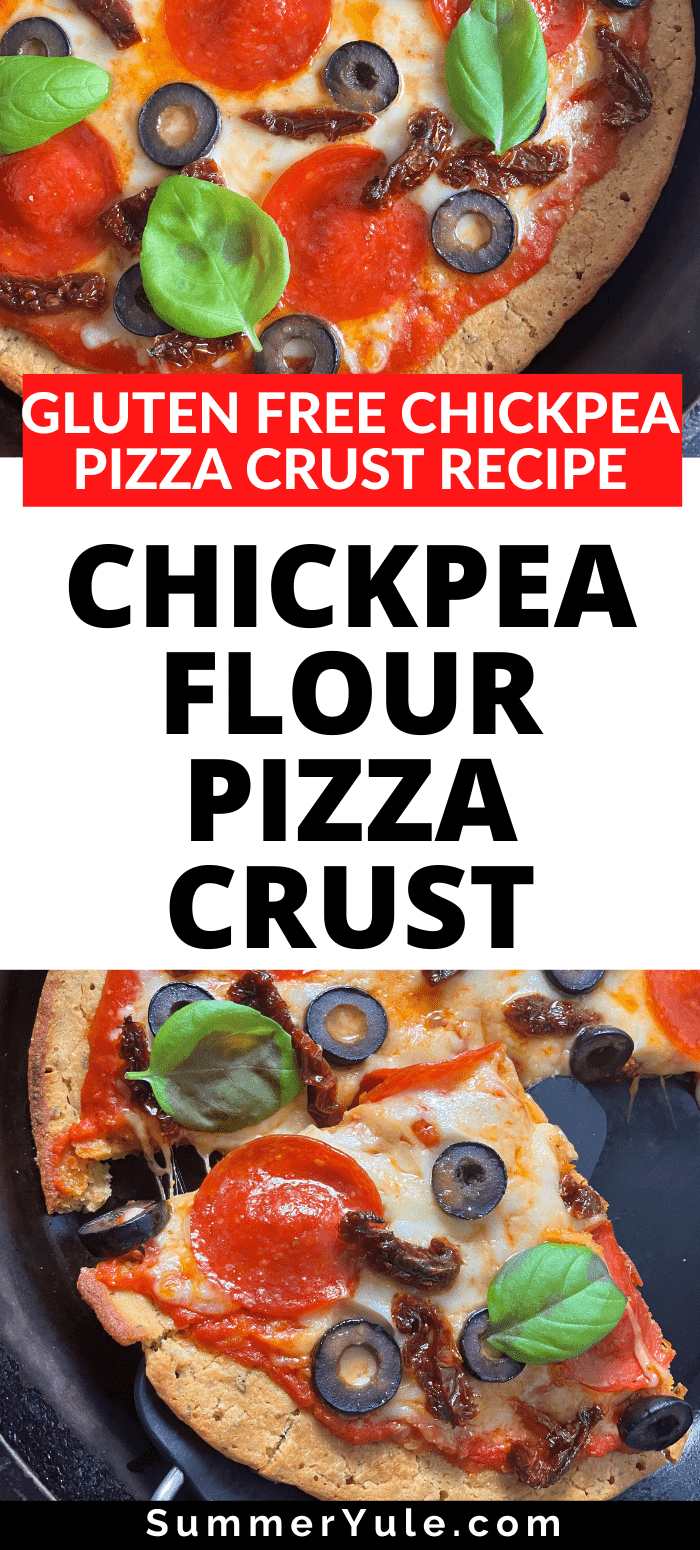
Pat says
I made a similar recipe with 1/2 cup buckwheat flour and 1/2 cup water with 1/2 tsp italian spices ,1 tsp olive oil . I whisked it together . pout into fry pan like a crepe , Cook a few minutes . Turn off , let sit . Then turn over and cook a little more . It's a thin crust and ready to top with favorite toppings . Be careful with the moisture of your toppings . Enjoy
I also eat gluten free.
Summer Yule says
That sounds like a wonderful idea for a gluten-free pizza crust! Thank you for visiting and leaving a recipe rating! 😀
Brian Hardin says
Great idea! My Mom can’t eat gluten so this would be ideal for her. Fantastic tip about avoiding topping with excessive moisture as well. Thanks for posting!
Summer Yule says
A lot of people are on gluten-free diets, so it can help to have other options! Thank you for dropping in 🙂
Brian Hardin says
Always enjoy your posts!
Summer Yule says
Thank you so much! I don't know if you saw my comment before but your kimchi video was amazingly well-done!
Brian Hardin says
Wow! Thanks! I really appreciate that!
Terrified Amateur says
Now you've gone and piqued my curiosity, Summer, as cauliflower is the only "alternative" type of crust I've tried, and I was positively impressed. Looking forward to the same with your idea, something I would've been hard-pressed to contemplate before cauliflower won me over.
I like how your innovations produce a crispy crust, something that will hold its own against the rigors of pizzahood.
As for toppings, well, my own site will feature pizza one month or another, and the choices, currently are between me and the pie. All will be revealed then (amidst much disappointment for sure), but for now allow me to build the "suspense!"
Summer Yule says
I look forward to seeing your spin on pizza! Pizza recipes tend to be fun to test because let's face it, even "bad" pizza tends to be pretty good!
I was recently experimenting with some skillet to oven sourdough pizza crust recipes. Yeast is still hard to obtain so having a lot of alternatives can be helpful!
Terrified Amateur says
Most assuredly, Summer!
I just ordered a pound of baker's yeast from Amazon, because I tired of being inspired to try something, only to have that enthusiasm founder on empty store shelves.
So, mid(ish)-crisis, everyone's making bread, hence the sudden scarcity? That's all I can figure.
Summer Yule says
Yeast is the last thing I haven't been able to get! I'm still holding out because I think a pound would last the rest of my life (and beyond LMAO).
Are you planning on splitting your order with people? You'd think with the popularity of low-carb diets the yeast would be back in stock by now. Apparently plenty of us are still eating bread!